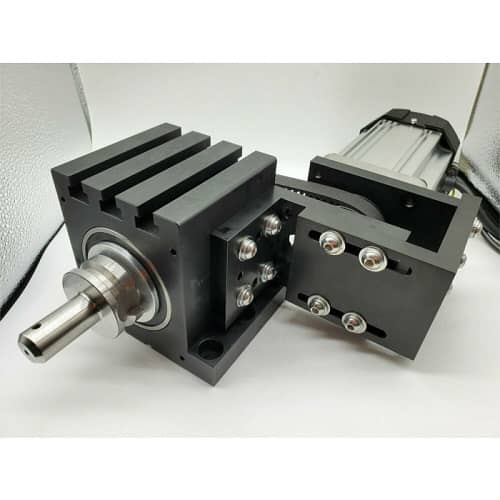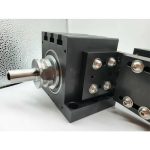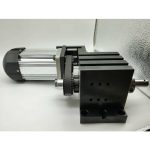BT-30 Headstock Taig & Sherline
Product Description
$747.0: BT-30 Headstock with ABEC-5 Sealed Deep Groove Bearing
If you need the following extra items, add them to your shopping cart:
- ABEC-7 Sealed Angular Contact Bearing - Precision Matched DB Set +$675.0
- ATC Ready Petal Clamp & Drawbar (belleville washers not included) +$247.0
- 2 Step 5 Rib Pully (40mm + 60mm steps) +$49.0
- Taig Mill Adapter +$99.0
Introducing The BT-30 Headstock!
Are you looking for the ultimate in precision and rigidity for a small headstock? Do you like the idea of quickly changing out tools? Then this is for you... You can now be among the first to get the GlockCNC BT-30 ATC Ready headstocks for Taig, Sherline, Chinese Mini Mill or custom mills. Until now, there were no bolt on headstocks that allowed for commercial grade 30 taper tooling. One of the great parts about owning a BT-30 headstock is the tooling availability. BT-30 tooling is very inexpensive for extremely high precision, tons of tooling types available and even lots of great quality used BT-30 tools available, if you want to go that route.
Is a BT-30 Taper Headstock Overkill For a Small Machine?
Initially, I wondered the same thing. Then I came up with the simple (if not obvious) solution...use bigger bearings that allow the tooling to fit deep up into the spindle bearings. By the time we finished engineering the whole thing, the headstock casing ended up being just 95mm (less than 4” tall) with minimal tool “stick-out” to conserve Z axis space. Yes, this is bigger than the stock Taig or Sherline headstock, but the payoff is huge by comparison.
Is There Any Advantage to the BT-30 System Over the R8 System?
We’ve done plenty of testing to answer that very question. As it turns out, there’s better vibration dampening, better finish quality and more precision...and here’s why;
Long Tool Taper - By using two good size Internal Dimension stacked bearings, we were able to fit almost the entire BT-30 tool taper up inside the bearings (a 3rd bearing holds the tail section of the spindle arbor). This my friend, puts the tooling load inside of the bearings, where all the work is being done...and frankly, that’s where the taper should be, high up into the bearings. (Take a look at the first image up to the right side on this page. See how far the tooling taper goes into the bearings? It actually goes a little further than what is shown, the 3D printed plastic spindle arbor shrank a little and didn't allow the tool to seat as far up as possible.) This is a significant advantage over an R8 spindle arbors. Most R8 spindles arbors hold the collet or tooling below the bearings...which is exactly where you don’t want it...especially on a smaller mill. Because most R8 spindle arbors hang well below the bearings, it acts like a lever putting a heavy angular load on the bearing for sideways cutting.
Tooling & Spindle Mass - BT-30 tooling is simply more robust than R8 tooling. Some may argue that the taper on both the BT-30 and R8, at the widest point, is close to the same and may not make a difference. However, there's more to the story than taper width. Testing shows the larger tooling mass, far longer taper, and larger spindle arbor for the BT-30 results in far better rigidity and vibration dampening. Once the BT-30 tool is seated in the spindle, the entire spindle now becomes one nice solid chunk of metal ready to do some real precision work.
Tooling Precision - Nowadays, anybody can find inexpensive BT-30 tooling good from 0.0001” to 0.0002” TIR (.0025mm to .004mm)...by comparison, most good R8 collets are .0005” to .0006” TIR. That means R8 tooling is 3 to 6 times less accurate than good BT-30 tooling! Simply put, you can find much more accurate tooling for BT-30 systems.
Tooling Variety - True, there is a lot of tooling for R8 spindles. However, your new BT-30 headstock will open you up to even more tooling options; including modular cutters. Plus, as mentioned before, the tooling offers much more precision than comparable R8 tooling.
Made From Solid 6061 Aluminum Billet - Of course, the images and video show the 3D printed version. You'll be getting a nice chuck of precision milled 6061 aluminum anodized in black. There's enough "meat" on this headstock to dampen vibration and if you need to do some custom drilling and tapping into the headstock, you can do that too.
How Does BT-30 Compare to Tormach Tooling System (TTS)
I really like the TTS for those who already have an R8 spindle. It’s a good compromise if that's your only choice. Tormach now has a nice selection of reasonably priced tooling too. I also like the idea of dual contact. They made a nice business centered around the TTS. That being said, many have experienced some real downfalls to the TTS.
Accuracy - As most machinists know, anything added between the bearings and the cutter create error or inaccuracy. TTS uses a flat nose ¾” collet, which adds runout and that holds on to the TTS tooling, which adds more runout. This is called “stacking error". It’s when you stack runout error on top of runout error. This reduces accuracy, reduces cutter life and can create chatter. BT-30 tooling can easily be found with .0001" or .0002" runout and it doesn't require an extra part inbetween the tooling and the spindle arbor. This radically reduces the chance for runout issues.
Slip Pullout - If you imagine what an end mill looks like, it looks like a screw. As you know, when a screw grabs into material, the screws helix pulls itself into the material as it’s twisted. The same happens with endmills. Endmills want to pull out of whatever is holding it. Normally, this isn’t a problem. But if the machine starts to chatter, then the grip on the TTS shaft can break and the tool holder is pulled out. Even a small amount of pullout can damage your part, ruin precision, break cutters and so on. Plus, if it creates a gap between the TTS dual contact face and the spindle arbor, you’ll loose the benefits of dual contact and create more angular stress on the hollow pull tube on the TTS tool.
Additional Details
 Updating...
Updating... 


